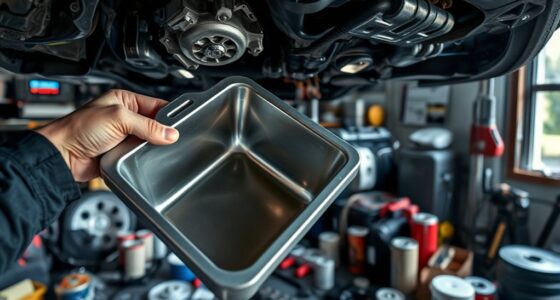To save time during oil changes, gather all supplies beforehand, including a spare filter, funnel, and drain pan with a built-in funnel. Warm up your engine first for smoother draining. Use an oil extraction pump instead of traditional draining to cut mess and effort. Keep a maintenance schedule to stay organized, and tighten parts with a torque wrench for a secure fit. Stick to these shortcuts, and you’ll discover more tips for a faster, cleaner oil change.
Key Takeaways
- Warm up the engine for 5-10 minutes to ensure thorough oil drainage and easier removal of deposits.
- Use a drain pan with a built-in funnel to minimize spills and streamline oil collection.
- Employ an oil extraction pump to remove oil through the dipstick, reducing mess and saving time.
- Keep a spare, pre-checked oil filter handy for quick replacement during oil changes.
- Follow a maintenance schedule with reminders to perform timely oil, filter, and fluid checks for optimal vehicle health.
Gather Your Supplies for a Quick Oil Change
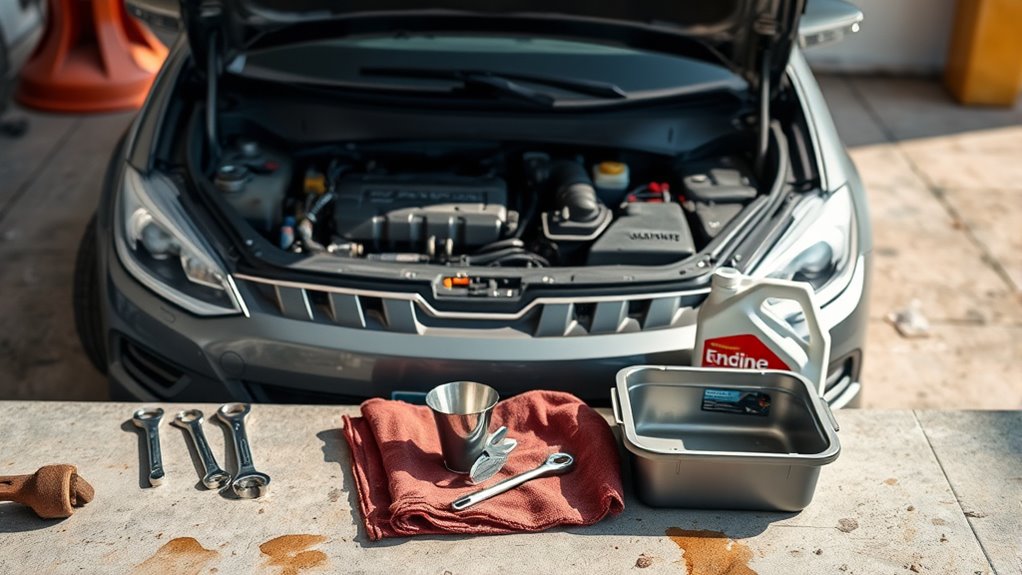
Have you gathered all the supplies you need before starting your oil change? First, grab a new oil filter to replace the old one, ensuring your engine stays clean. You’ll also need a wrench to remove the drain plug, which is essential for draining old oil. Make sure you have a drain pan to catch the oil as it flows out and some gloves to keep your hands clean. Don’t forget fresh oil, typically specified in your vehicle’s manual. A funnel helps pour the new oil without spills. Check for a rubber gasket on the oil filter and the drain plug to prevent leaks. Having everything ready saves time and makes the process smoother, so double-check your list before you start. Also, ensure you understand the proper oil change process to avoid any mistakes.
Warm Up the Engine for Easier Draining
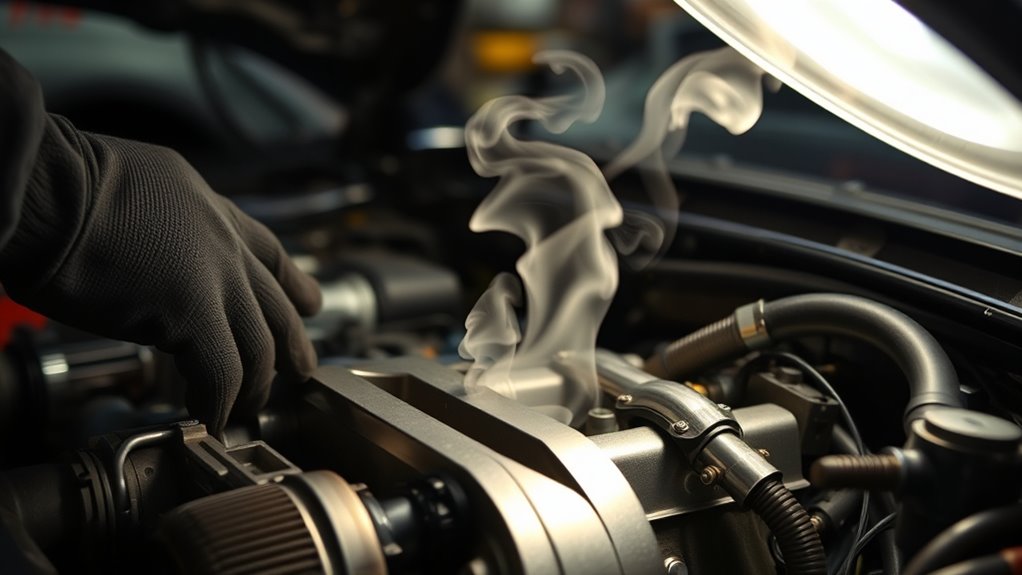
Warming up your engine before draining the oil helps it flow more smoothly. This prevents the oil from clogging and guarantees a thorough drain. Just start the engine and let it run for a few minutes before turning it off. Additionally, ensuring your vehicle has a reliable oil change process can further optimize maintenance and prevent potential issues.
Warm Engine First
Turning on your engine and letting it run for a few minutes helps warm the oil, making it flow more smoothly and drain more completely. As the engine temperature rises, the oil’s viscosity decreases, meaning it becomes thinner and easier to drain. Warm oil moves more freely through the engine components, reducing the chance of leftover sludge or debris clogging the drain. This quick warm-up ensures you get a more thorough oil change and minimizes the effort needed to drain old oil. Keep the engine running just long enough to reach a comfortable temperature—usually about 5-10 minutes. Avoid over-warming, as excessively hot oil can be difficult to handle safely. Warming the engine first is a simple step that pays off with a cleaner, more efficient drain. Monitoring oil temperature can help you determine the optimal warm-up period for a safe and effective oil change.
Prevents Oil Clogging
By warming up the engine before draining the oil, you help prevent clogging caused by thick, sticky deposits. A warm engine thins the oil, making it flow more freely and ensuring contaminants don’t settle into stubborn clogs. This process promotes better oil clogging prevention, reducing the risk of buildup that can restrict oil flow over time. When oil drains smoothly, you also support engine longevity by removing sludge and debris efficiently. Warming the engine slightly before draining isn’t just about convenience; it’s a smart step to keep your engine running smoothly longer. Proper temperature management can also enhance color accuracy during the oil change process, ensuring the best possible results. Regularly using this shortcut helps maintain ideal oil flow, ultimately protecting your engine from unnecessary wear and tear caused by clogged passages.
Use a Funnel for a Cleaner, Faster Oil Refill
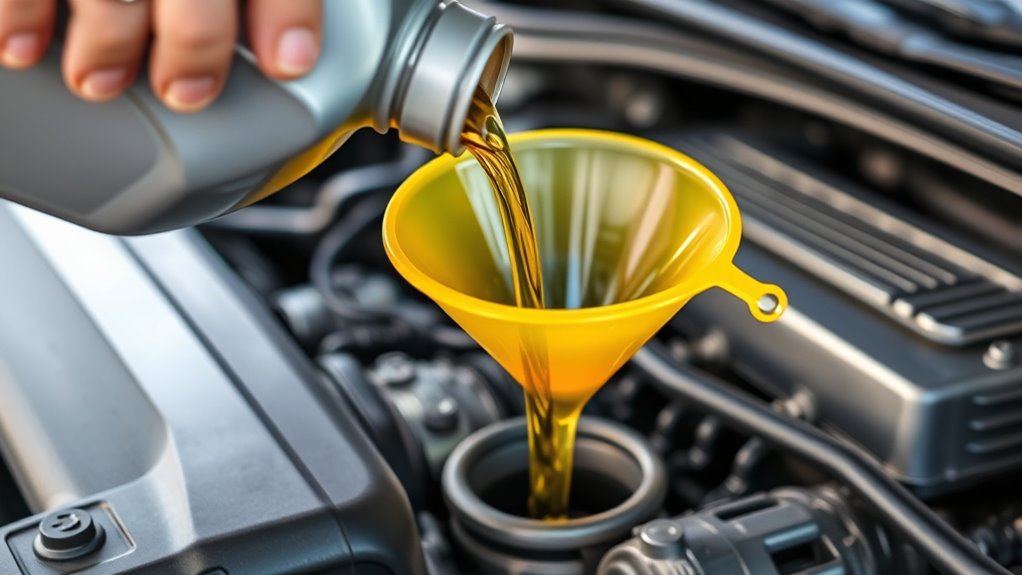
Using a funnel when refilling your oil helps keep the process clean and quick. An oil funnel prevents spills and guarantees you don’t waste valuable oil. To maximize its benefits, follow these tips:
- Select the right size oil funnel for your vehicle’s fill port.
- Insert the funnel securely to avoid accidental spills.
- Pour oil slowly to maintain spill prevention and control flow.
- Keep the funnel clean after use to prevent debris buildup.
- Consider using tuning software to optimize your engine’s performance and efficiency after maintenance.
Using a funnel streamlines the process and keeps your engine bay tidy. It also minimizes messes, saving you time and effort. A quality oil funnel makes a noticeable difference, especially when working in tight spaces or with thick oil. Keep your refills clean and quick by always using a funnel—your best spill prevention tool.
Opt for a Shorter Oil Change Interval if Using High-Quality Oil

Using high-quality oil means it lasts longer, so you can shorten your oil change intervals. This approach reduces how often you need maintenance and saves you money over time. It’s a simple way to keep your engine running smoothly without extra hassle. Additionally, choosing the right oil change frequency based on your vehicle’s needs can further optimize engine performance and longevity.
Better Oil Durability
High-quality oil often lasts longer and resists breakdown better than standard options, which can tempt you to extend your oil change intervals. Using synthetic oils with advanced oil additives enhances durability, allowing your engine to perform at its best for longer periods. To maximize this benefit, consider these tips:
- Choose synthetic oils formulated with effective oil additives for extra protection.
- Follow your vehicle’s recommended oil change schedule, but don’t hesitate to shorten it if you notice increased driving stress.
- Regularly check oil levels to ensure the oil remains effective.
- Use high-quality filters that complement the durability of synthetic oils for better engine protection.
- Understanding Gold IRA fees can help you allocate resources wisely if you’re considering diversifying your long-term investments.
Reduced Maintenance Frequency
Thanks to the enhanced durability of synthetic oils and advanced additives, you can often extend the time between oil changes without risking engine health. This means you can reduce maintenance frequency by opting for longer intervals, especially if you’re using high-quality oil. Just be sure to check the condition of your oil filter regularly, as a clean filter helps maintain ideal engine performance. When it’s time for an oil change, don’t forget to remove and replace the drain plug properly to ensure a complete drain of old oil. Extending your oil change schedule saves you time and effort, but always monitor your engine’s performance. If you notice any unusual noises or oil consumption, consider returning to a more frequent maintenance routine to keep your engine running smoothly. Additionally, Mazda B2200 tuning can benefit from proper oil maintenance to optimize engine longevity.
Cost-Effective Solution
Opting for a shorter oil change interval can be a cost-effective choice when you use high-quality synthetic oils. This approach saves you money over time by reducing the need for frequent visits to the mechanic. Here are some cost-saving tips to maximize your budget-friendly upgrades:
- Choose high-quality synthetic oil for better engine protection and longer intervals.
- Monitor your vehicle’s performance to adjust oil change frequency if needed.
- Use oil analysis kits to determine the most suitable oil change schedule.
- Follow manufacturer recommendations alongside your observations for a tailored approach.
- Be aware of Required Minimum Distributions (RMDs) if you are also managing retirement accounts, as understanding the rules can help you plan your finances more effectively.
Employ an Oil Extraction Pump to Save Time and Mess

Have you considered using an oil extraction pump to make the oil change process quicker and cleaner? An oil extraction pump can considerably reduce the mess and effort involved in draining old oil. Its efficiency lies in removing nearly all the oil without crawling under the vehicle or removing the drain plug. By creating a vacuum, the pump pulls out the oil directly from the dipstick tube or fill port, minimizing spills. This method also shortens the time spent waiting for gravity to do its job. Plus, the pump’s effectiveness ensures you get most of the oil out, leaving less residue behind. Using a specialized oil extraction tool can further improve your results and ease the process. Overall, employing an oil extraction pump streamlines your oil change, saves time, and keeps your workspace cleaner.
Keep a Spare Oil Filter on Hand for Faster Replacement

Keeping a spare oil filter nearby can substantially speed up your oil filter replacement. Instead of waiting for a new filter to arrive or searching for one, you can swap it out instantly. To maximize this shortcut, keep these four tips in mind:
Keep a spare oil filter on hand to speed up your oil change process effortlessly.
- Choose the correct spare oil filter compatible with your vehicle.
- Store it in a clean, accessible spot in your garage.
- Regularly check the spare’s expiration date or condition.
- Pre-prepare tools like a wrench to make removal and installation quicker.
Having a spare oil filter ready reduces downtime during oil changes, especially if you’re pressed for time. It also minimizes the risk of forgetting to buy or replace the filter, ensuring your oil filter replacement is fast and efficient.
Use a Torque Wrench to Ensure Proper Tightening Quickly
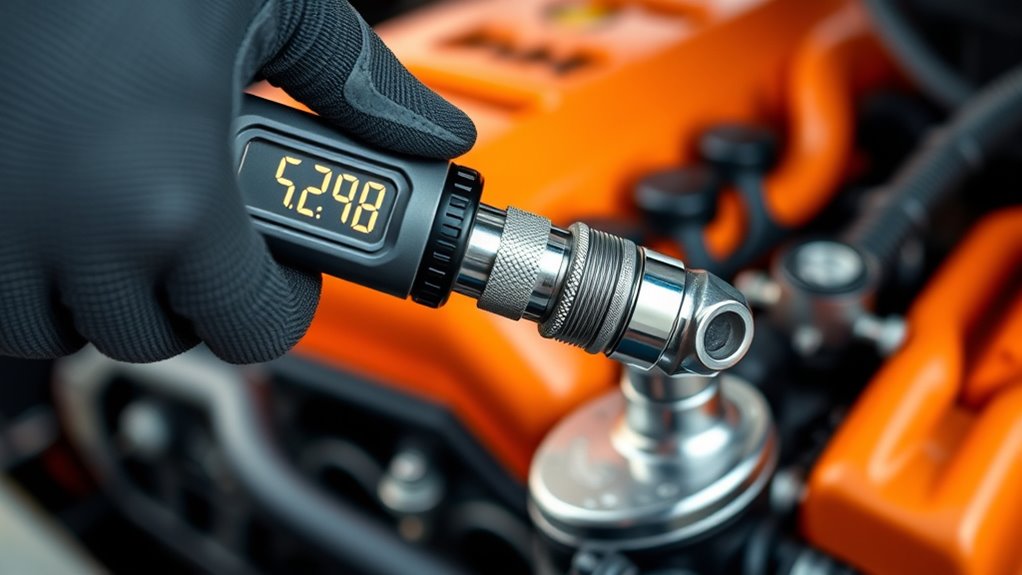
Using a torque wrench guarantees you tighten your oil drain plug and filter to the manufacturer’s specifications quickly and accurately, preventing over-tightening or under-tightening. This tool simplifies proper tightening by giving you a precise measurement, saving time and reducing guesswork. Set the torque wrench to the recommended setting for your vehicle, then tighten until it clicks, indicating proper tightening. This ensures your components are secure without risking damage. A torque wrench is especially useful if you’re new to oil changes or working on multiple vehicles, as it streamlines the process and ensures consistency. By using this tool, you avoid potential leaks or stripped threads, making your oil change safer and more efficient. Proper tightening with a torque wrench keeps your vehicle running smoothly.
Employ a Drain Pan With a Built-In Funnel for Less Spillage
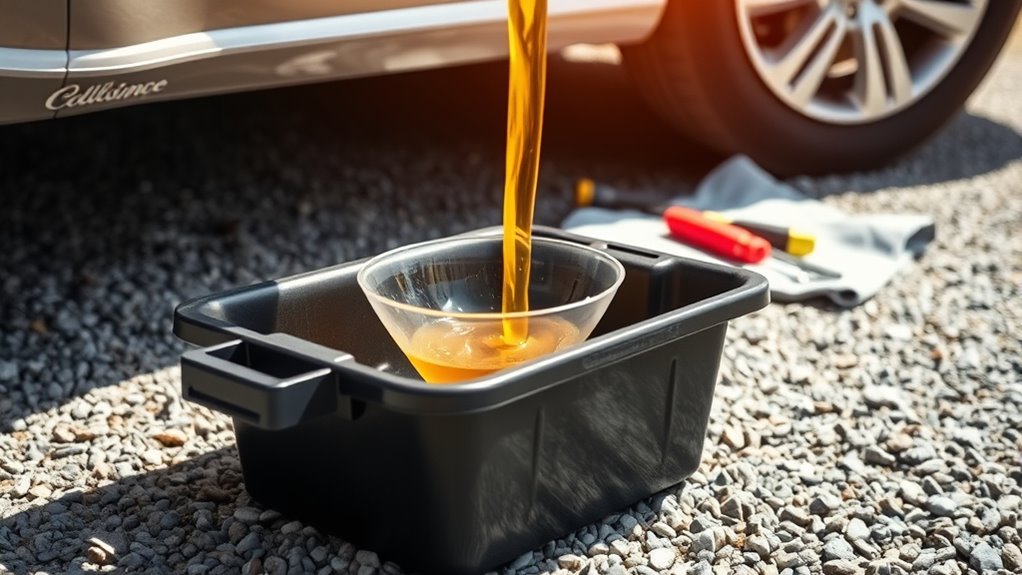
A drain pan with a built-in funnel makes the oil drain process cleaner and more efficient by minimizing spills. Its innovative funnel design directs oil smoothly from the drain port into your container, reducing cleanup time. To maximize its benefits:
Using a drain pan with a built-in funnel ensures a cleaner, faster oil change with minimal spills.
- Choose a drain pan with a wide, stable base to prevent tipping.
- Ensure the funnel fits snugly into the pan for a secure seal.
- Position the pan directly under the oil drain for precise alignment.
- Use the funnel to guide oil into your container without splashing.
This setup not only cuts down on mess but also speeds up the oil drain process. The funnel design keeps spills contained, so you spend less time cleaning and more time on the job.
Create a Maintenance Schedule to Streamline Your Workflow

Creating a maintenance schedule for your oil changes helps you stay organized and guarantees timely service, preventing costly engine damage. By setting regular intervals, you ensure your vehicle runs smoothly and extend its lifespan. Use a maintenance checklist to track oil change dates, fluid levels, and filter replacements. Scheduling tips include setting reminders on your phone or calendar and sticking to consistent intervals based on your vehicle’s needs. To emphasize, here’s a sample schedule:
| Service Item | Frequency |
|---|---|
| Oil Change | Every 3,000-5,000 miles |
| Filter Replacement | Every 10,000 miles |
| Fluid Checks | Monthly |
| Tire Rotation | Every 6,000 miles |
A well-planned maintenance routine saves time and reduces the risk of breakdowns, making your workflow more efficient.
Frequently Asked Questions
Can I Change My Oil Without Lifting the Car?
You can change your oil without lifting the car by accessing the drain plug and oil pan from underneath. Use a jack and jack stands or ramps to raise the vehicle safely, then locate the drain plug to drain the old oil. Once drained, remove the oil filter, refill with new oil, and replace the drain plug securely. This method lets you change your oil efficiently without fully lifting the car.
What’s the Best Type of Oil for Quick Changes?
Thinking about quick oil changes? You’ll want a synthetic oil with the right viscosity for smooth draining and engine protection, making your task easier and faster. Opt for an oil filter designed for quick swaps, which can save you time and frustration. Synthetic oils like 5W-30 or 0W-20 flow easily, helping you get the job done swiftly and efficiently without sacrificing quality.
How Often Should I Check My Oil Level?
You should check your oil level at least once a month or every 1,000 miles, whichever comes first. Regular checking frequency helps you catch low oil levels early and avoid engine damage. Pull out the dipstick, wipe it clean, then reinsert and remove it to see the oil level. Keep an eye on the oil level regularly, especially before long trips or after harsh driving conditions, for peak engine health.
Are Synthetic Oils Better for Shortcuts?
Synthetic oils are like the Swiss Army knives of engine lubricants—versatile and efficient. They’re definitely better for shortcuts, offering advantages like improved oil longevity and better engine protection. Plus, they flow more easily at low temperatures, giving you smoother starts. While they might cost more upfront, their durability often means fewer changes. So, if you’re aiming for quick, reliable oil changes, synthetic oils are your best bet for lasting performance.
Can I Reuse Old Oil Filters Safely?
You shouldn’t reuse old oil filters because their oil filter compatibility may be compromised, reducing their ability to effectively trap contaminants. Reuse safety isn’t recommended since reused filters can develop cracks or damage, leading to leaks or engine damage. Always replace your oil filter with a new one to guarantee proper filtration and protection. This simple step helps maintain your engine’s health and keeps your shortcut oil change efficient and safe.
Conclusion
By following these shortcuts, you can cut your oil change time in half without sacrificing quality. Did you know that regular, efficient oil changes can extend your engine’s lifespan by up to 20%? Staying organized and using the right tools not only saves you time but also keeps your vehicle running smoothly. So, keep these tips in mind, and you’ll be surprised how quickly a simple oil change becomes a hassle-free task.



